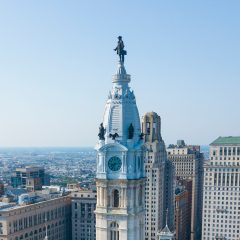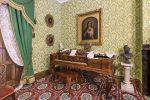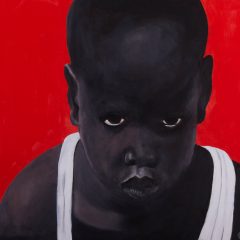A sense of wonderment
When you walk into the Stedman Gallery at Rutgers Camden, the first thing you encounter is a large, framed, radiant portrait of a young woman standing in the sunlight on a patch of grass in front of a wooded area, wearing a grand white gown. At first, this appears to be a photorealistic painting. Then you realize that the figure is moving, ever so slightly, and that you are experiencing a video projection.
The sense of wonderment that this piece conveys continues throughout the exhibition, enhanced by a strange, alluring soundtrack playing in the background (part of one of the other installations), an ambiguous, gospelly chorus of voice, breath, and the chirping of crickets.
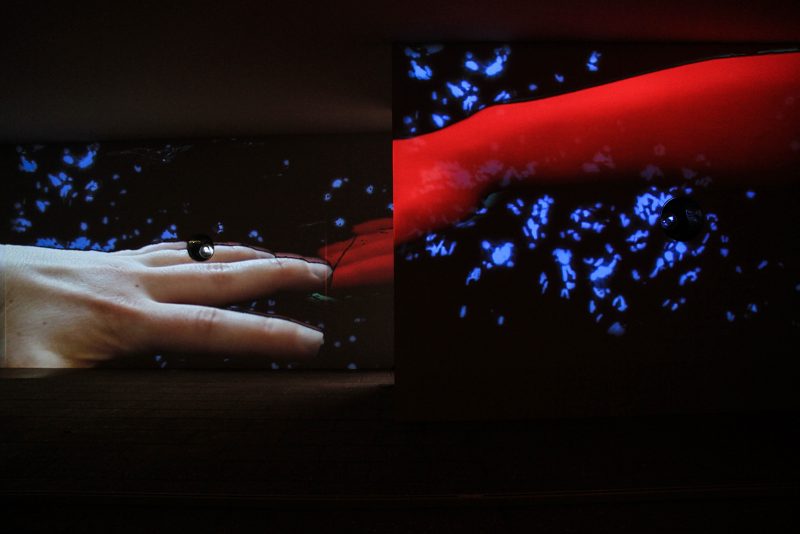
Genesis of the exhibition
Space Invaders is a group show curated by Philadelphia Sculptors president Leslie Kaufman, that features the work of five women artists — all veterans of last year’s Artship Olympia show — Elizabeth Mackie, Andi Steele, Kaitlyn Paston, Joanna Platt, and Jacintha Clark (with an assist from animator Jeremy Maas). [Editor’s note: read Flora Ward’s 2016 review of Artship Olympia for Artblog here] The exhibition is unusual in that the contributors created work specifically for the show, with the intention that their creations would respond to the gallery space and also connect or respond to the work of the other artists in the show.
For example, the white gown that appears in the projection described above – “Alyssa,” by Elizabeth Mackie — appears in real life in another part of the show (hanging from the ceiling), and a miniaturized image of the video-portrait appears in the work of one of the other artists.
The exhibition focuses upon the dynamic use and perception of space and time, upon illusion and reality, upon the continuum between the internal and external, and upon the connections between the works of art displayed — connections expressed with varying degrees of subtlety.
Andi Steele — waves and planes of empty space
Just beyond Mackie’s projection, the visitor is greeted in the gallery by Andi Steele’s “Meanders.” Steele has strung a passageway in the gallery with glimmering and pulsating strands of monofilament which transform with the shifting light as you are guided through the field. Viewed from the outside, the installation seems to dissect space, to reveal the otherwise invisible waves and planes that occupy its path.
Joanna Platt’s junction boxes
The exhibition includes Joanna Platt’s “Outside In,” which at first appears to be a wall of connected industrial junction boxes. Each of the boxes encases an image, which can be seen through a convex lens on its face. There are both still and moving images embedded in the junction boxes — some of them are autobiographical, some portray the natural world, some contain miniaturized works that appear in other areas of the show. The internalized imagery replicates memory and reflects the artist’s experience in the world, including her connection to other facets of the exhibit itself. The display led me to think about what goes on beneath the surface, our infrastructure, about linked neurons, about how we piece together our perceptions and organize our lives.
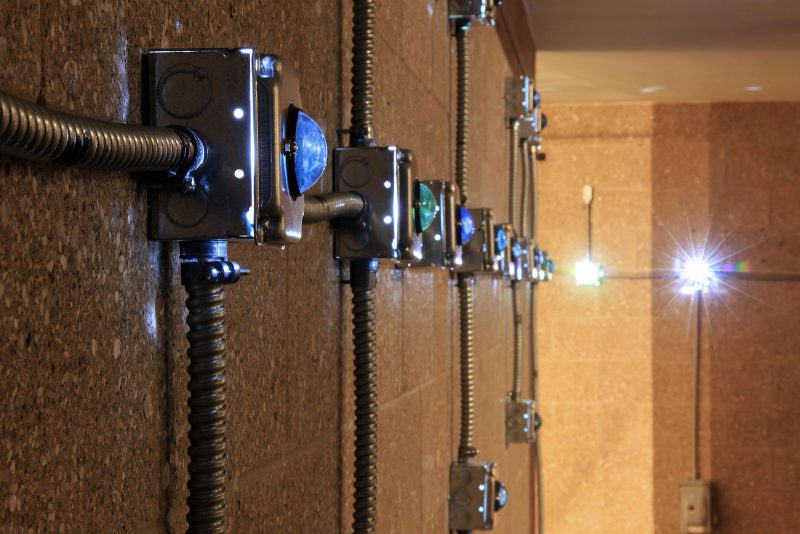
Kaitlin Paston – dancing hands
In the rear of the gallery, in a tall space no wider than a hallway, you come upon Kaitlyn Paston’s captivating “Wiggle Room.” This is where the soundtrack that invades the rest of the gallery originates. The installation consists of a brilliant, three-channel video projected onto the area’s bi-level ceiling. The video’s interwoven, partially-abstract projections, which at times reach down the walls of the gallery and then retreat back upwards, feature human arms and hands dancing and interlacing in and upon a colorful, viscous medium. It suggests themes evident across the exhibition — interconnection, reaching out into space and across divides, and our efforts to occupy and master our environment.
Jacintha Clark – shape and shadow
Jacintha Clark’s “Shape, Shadow, Space,” which along with other works of hers, occupies a central wall in the gallery, is enchanting in its simplicity. Her beautiful and graceful archetypal blinds, shown here, rendered in porcelain, and their shadows reflected on the wall, elegantly demonstrate the dimensions of light, together with beautiful vagaries of positive and negative space — themes which are explored thoroughly in other parts of this exhibition.
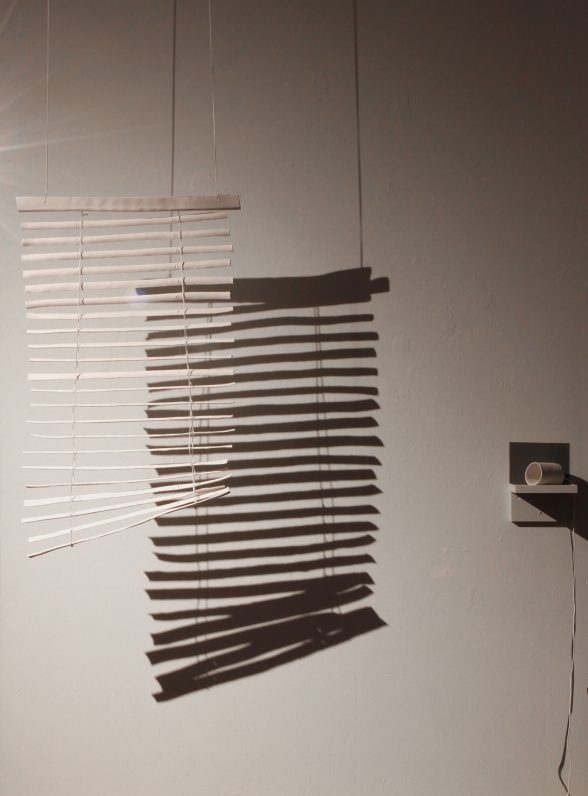
Jacintha Clark and Jeremy Maas – a fantastic still life
Clark also teamed up with the animator, Jeremy Mass, to create “Still Life,” a delightful, colorful fantasy landscape in porcelain enhanced by video mapping of, among other features, small animatronic “bug bots” that roam the landscape. The installation also includes projections on the walls surrounding the piece which are so harmonious with the physical architecture of the work that they resemble shadows. This installation uses space, color, and light to posit and explore a fourth dimension.
If there is a weakness in the show, it may be Elizabeth Mackie’s fiber pieces — oversized skirts of different fabrics hanging from the ceiling with videos of moving tree branches and leaf and floral patterns projected onto some of their surfaces. I found this work less effective than the other pieces in the exhibition at exploring the vicissitudes of time and space.
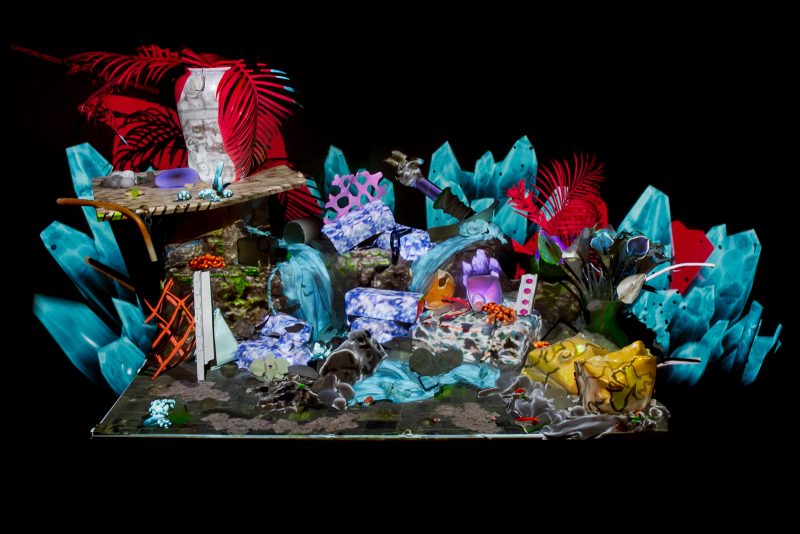
Space Invaders is a powerful exhibit which mixes physical art and objects with digital projections, light and sound, and transforms the otherwise institutional space of this gallery into a wonderland.
Cross the river and see it. It’s well worth the excursion. There’s a YouTube video about the show, which will be up at the the Rutgers Stedman Gallery through April 18th.



